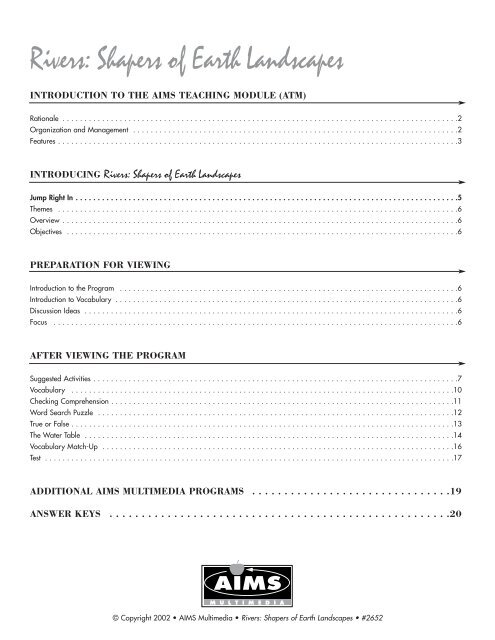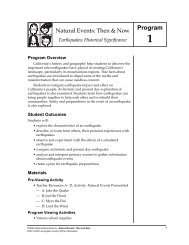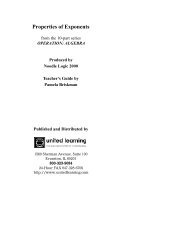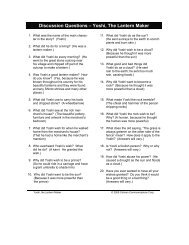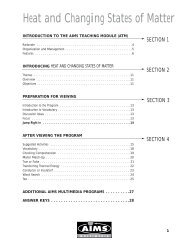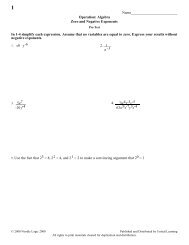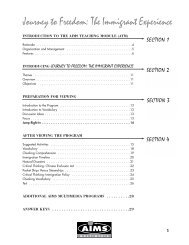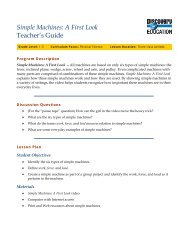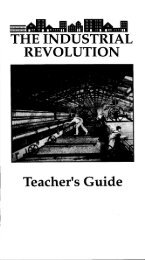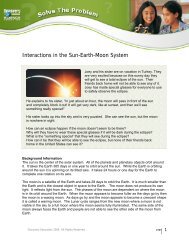Rivers: Shapers of Earth Landscapes
Rivers: Shapers of Earth Landscapes
Rivers: Shapers of Earth Landscapes
You also want an ePaper? Increase the reach of your titles
YUMPU automatically turns print PDFs into web optimized ePapers that Google loves.
<strong>Rivers</strong>: <strong>Shapers</strong> <strong>of</strong> <strong>Earth</strong> <strong>Landscapes</strong>INTRODUCTION TO THE AIMS TEACHING MODULE (ATM)Rationale . . . . . . . . . . . . . . . . . . . . . . . . . . . . . . . . . . . . . . . . . . . . . . . . . . . . . . . . . . . . . . . . . . . . . . . . . . . . . . . . . . . . . . . . . .2Organization and Management . . . . . . . . . . . . . . . . . . . . . . . . . . . . . . . . . . . . . . . . . . . . . . . . . . . . . . . . . . . . . . . . . . . . . . . . . .2Features . . . . . . . . . . . . . . . . . . . . . . . . . . . . . . . . . . . . . . . . . . . . . . . . . . . . . . . . . . . . . . . . . . . . . . . . . . . . . . . . . . . . . . . . . . .3INTRODUCING <strong>Rivers</strong>: <strong>Shapers</strong> <strong>of</strong> <strong>Earth</strong> <strong>Landscapes</strong>Jump Right In . . . . . . . . . . . . . . . . . . . . . . . . . . . . . . . . . . . . . . . . . . . . . . . . . . . . . . . . . . . . . . . . . . . . . . . . . . . . . . . . . . . . . . .5Themes . . . . . . . . . . . . . . . . . . . . . . . . . . . . . . . . . . . . . . . . . . . . . . . . . . . . . . . . . . . . . . . . . . . . . . . . . . . . . . . . . . . . . . . . . . .6Overview . . . . . . . . . . . . . . . . . . . . . . . . . . . . . . . . . . . . . . . . . . . . . . . . . . . . . . . . . . . . . . . . . . . . . . . . . . . . . . . . . . . . . . . . . .6Objectives . . . . . . . . . . . . . . . . . . . . . . . . . . . . . . . . . . . . . . . . . . . . . . . . . . . . . . . . . . . . . . . . . . . . . . . . . . . . . . . . . . . . . . . . .6PREPARATION FOR VIEWINGIntroduction to the Program . . . . . . . . . . . . . . . . . . . . . . . . . . . . . . . . . . . . . . . . . . . . . . . . . . . . . . . . . . . . . . . . . . . . . . . . . . . . .6Introduction to Vocabulary . . . . . . . . . . . . . . . . . . . . . . . . . . . . . . . . . . . . . . . . . . . . . . . . . . . . . . . . . . . . . . . . . . . . . . . . . . . . . .6Discussion Ideas . . . . . . . . . . . . . . . . . . . . . . . . . . . . . . . . . . . . . . . . . . . . . . . . . . . . . . . . . . . . . . . . . . . . . . . . . . . . . . . . . . . . .6Focus . . . . . . . . . . . . . . . . . . . . . . . . . . . . . . . . . . . . . . . . . . . . . . . . . . . . . . . . . . . . . . . . . . . . . . . . . . . . . . . . . . . . . . . . . . . .6AFTER VIEWING THE PROGRAMSuggested Activities . . . . . . . . . . . . . . . . . . . . . . . . . . . . . . . . . . . . . . . . . . . . . . . . . . . . . . . . . . . . . . . . . . . . . . . . . . . . . . . . . . .7Vocabulary . . . . . . . . . . . . . . . . . . . . . . . . . . . . . . . . . . . . . . . . . . . . . . . . . . . . . . . . . . . . . . . . . . . . . . . . . . . . . . . . . . . . . . .10Checking Comprehension . . . . . . . . . . . . . . . . . . . . . . . . . . . . . . . . . . . . . . . . . . . . . . . . . . . . . . . . . . . . . . . . . . . . . . . . . . . . . .11Word Search Puzzle . . . . . . . . . . . . . . . . . . . . . . . . . . . . . . . . . . . . . . . . . . . . . . . . . . . . . . . . . . . . . . . . . . . . . . . . . . . . . . . . .12True or False . . . . . . . . . . . . . . . . . . . . . . . . . . . . . . . . . . . . . . . . . . . . . . . . . . . . . . . . . . . . . . . . . . . . . . . . . . . . . . . . . . . . . . .13The Water Table . . . . . . . . . . . . . . . . . . . . . . . . . . . . . . . . . . . . . . . . . . . . . . . . . . . . . . . . . . . . . . . . . . . . . . . . . . . . . . . . . . . .14Vocabulary Match-Up . . . . . . . . . . . . . . . . . . . . . . . . . . . . . . . . . . . . . . . . . . . . . . . . . . . . . . . . . . . . . . . . . . . . . . . . . . . . . . . .16Test . . . . . . . . . . . . . . . . . . . . . . . . . . . . . . . . . . . . . . . . . . . . . . . . . . . . . . . . . . . . . . . . . . . . . . . . . . . . . . . . . . . . . . . . . . . . .17ADDITIONAL AIMS MULTIMEDIA PROGRAMS . . . . . . . . . . . . . . . . . . . . . . . . . . . . . . .19ANSWER KEYS . . . . . . . . . . . . . . . . . . . . . . . . . . . . . . . . . . . . . . . . . . . . . . . . . . . . .20© Copyright 2002 • AIMS Multimedia • <strong>Rivers</strong>: <strong>Shapers</strong> <strong>of</strong> <strong>Earth</strong> <strong>Landscapes</strong> • #2652
Congratulations!You have chosen a learning program that will actively motivate your students and provide you with easily accessible and easily manageableinstructional guidelines and tools designed to make your teaching role efficient and rewarding.The AIMS Teaching Module (ATM) provides you with a video program correlated to your classroom curriculum, instructions and guidelines foruse, plus a comprehensive teaching program containing a wide range <strong>of</strong> activities and ideas for interaction between all content areas. Ourauthors, educators, and consultants have written and reviewed the AIMS Teaching Modules to align with the Educate America Act: Goals 2000.This ATM, with its clear definition <strong>of</strong> manageability, both in the classroom and beyond, allows you to tailor specific activities to meet all <strong>of</strong> yourclassroom needs.RATIONALEORGANIZATION AND MANAGEMENTIn today’s classrooms, educational pedagogy is <strong>of</strong>ten founded onBenjamin S. Bloom’s “Six Levels <strong>of</strong> Cognitive Complexity.” Thepractical application <strong>of</strong> Bloom’s Taxonomy is to evaluate students’thinking skills on these levels, from the simple to the complex:1. Knowledge (rote memory skills),2. Comprehension (the ability to relate or retell),3. Application (the ability to apply knowledge outside its origin),4. Analysis (relating and differentiating parts <strong>of</strong> a whole),5. Synthesis (relating parts to a whole)6. Evaluation (making a judgment or formulating an opinion).To facilitate ease in classroom manageability, the AIMS TeachingModule is organized in three sections:I. Introducing this ATMwill give you the specific information you need to integrate theprogram into your classroom curriculum.II. Preparation for Viewingprovides suggestions and strategies for motivation, languagepreparedness, readiness, and focus prior to viewing the programwith your students.The AIMS Teaching Module is designed to facilitate these intellectualcapabilities, and to integrate classroom experiences and assimilation<strong>of</strong> learning with the students’ life experiences, realities, andexpectations. AIMS’ learner verification studies prove that our AIMSTeaching Modules help students to absorb, retain, and to demonstrateability to use new knowledge in their world. Our educationalmaterials are written and designed for today’s classroom, whichincorporates a wide range <strong>of</strong> intellectual, cultural, physical, andemotional diversities.III. After Viewing the Programprovides suggestions for additional activities plus an assortment <strong>of</strong>consumable assessment and extended activities, designed to broadencomprehension <strong>of</strong> the topic and to make connections to othercurriculum content areas.AIMS Teaching Module written by Pat Davies© Copyright 2002 AIMS MultimediaAll Rights Reserved. No part <strong>of</strong> this work may be reproduced or transmitted without written permission <strong>of</strong> AIMS Multimedia with these exceptions: Persons or schools purchasing thisAIMS Teaching Module may reproduce consumable ATM pages, identified in Section 4, for student or classroom use.AIMS Multimedia is a leading producer and distributor <strong>of</strong> educational programs serving schools and libraries since 1957. AIMS draws upon the most up-to-date knowledge, existingand emerging technologies, and all <strong>of</strong> the instructional and pedagogical resources available to develop and distribute educational programs in videocassette and CD-ROM.Persons or schools interested in obtaining additional copies <strong>of</strong> this AIMS Teaching Module, please contact:AIMS Multimedia at:Toll Free: 1-800-367-2467Fax: 818-341-6700Web: www.aimsmultimedia.comEmail: info@aimsmultimedia.com2© Copyright 2002 • AIMS Multimedia • <strong>Rivers</strong>: <strong>Shapers</strong> <strong>of</strong> <strong>Earth</strong> <strong>Landscapes</strong> • #2652
FEATURESINTRODUCING THE ATMYour AIMS Teaching Module is designed toaccompany a video program written andproduced by some <strong>of</strong> the world’s mostcredible and creative writers and producers<strong>of</strong> educational programming. To facilitatediversity and flexibility in your classroomand to provide assessment tools, your AIMSTeaching Module features these components:ThemesThis section tells how the AIMS TeachingModule is correlated to the curriculum.Themes <strong>of</strong>fers suggestions for interactionwith other curriculum content areas,enabling teachers to use the teachingmodule to incorporate the topic into avariety <strong>of</strong> learning areas.OverviewThe Overview provides a synopsis <strong>of</strong> contentcovered in the video program. Its purpose isto give you a summary <strong>of</strong> the subject matterand to enhance your introductorypreparation.ObjectivesThe ATM learning objectives provideguidelines for teachers to assess whatlearners can be expected to gain from eachprogram. After completion <strong>of</strong> the AIMSTeaching Module, your students will be ableto demonstrate dynamic and appliedcomprehension <strong>of</strong>”” the topic.Preparation for ViewingIn preparation for viewing the videoprogram, the AIMS Teaching Module <strong>of</strong>fersactivity and/or discussion ideas that youmay use in any order or combination.Introduction To The ProgramIntroduction to the Program is designed toenable students to recall or relate priorknowledge about the topic and to preparethem for what they are about to learn.Introduction To VocabularyIntroduction to Vocabulary is a review <strong>of</strong>language used in the program: words,phrases, and usage. This vocabularyintroduction is designed to ensure that alllearners, including limited Englishpr<strong>of</strong>iciency learners, will have fullunderstanding <strong>of</strong> the language usage in thecontent <strong>of</strong> the program.Discussion IdeasDiscussion Ideas are designed to help youassess students’ prior knowledge about thetopic and to give students a preview <strong>of</strong> whatthey will learn. Active discussion stimulatesinterest in a subject and can motivate eventhe most reluctant learner. Listening, as wellas speaking, is active participation.Encourage your students to participate at therate they feel comfortable. Model sharingpersonal experiences when applicable, andmodel listening to students’ ideas andopinions.FocusHelp learners set a purpose for watching theprogram with Focus, designed to givestudents a focal point for comprehensioncontinuity.Jump Right InJump Right In provides abbreviatedinstructions for quick management <strong>of</strong> theprogram.After Viewing the ProgramAfter your students have viewed theprogram, you may introduce any or all <strong>of</strong>these activities to interact with othercurriculum content areas, providereinforcement, assess comprehension skills,or provide hands-on and in-depth extendedstudy <strong>of</strong> the topic.3© Copyright 2002 • AIMS Multimedia • <strong>Rivers</strong>: <strong>Shapers</strong> <strong>of</strong> <strong>Earth</strong> <strong>Landscapes</strong> • #2652
SUGGESTED ACTIVITIESThe Suggested Activities <strong>of</strong>fer ideas foractivities you can direct in the classroom orhave your students complete independently,in pairs, or in small work groups after theyhave viewed the program. To accommodateyour range <strong>of</strong> classroom needs, the activitiesare organized into skills categories. Theirlabels will tell you how to identify eachactivity and help you correlate it into yourclassroom curriculum. To help you scheduleyour classroom lesson time, the AIMShourglass gives you an estimate <strong>of</strong> the timeeach activity should require. Some <strong>of</strong> theactivities fall into these categories:Meeting Individual NeedsThese activities are designedto aid in classroom continuity.Reluctant learners andlearners acquiring Englishwill benefit from theseactivities geared to enhance comprehension<strong>of</strong> language in order to fully grasp contentmeaning.Curriculum ConnectionsMany <strong>of</strong> the suggestedactivities are intended toARTintegrate the content <strong>of</strong> theATM program into othercontent areas <strong>of</strong> theclassroom curriculum. These crossconnectionsturn the classroom teachingexperience into a whole learningexperience.Critical ThinkingCritical Thinking activities aredesigned to stimulatelearners’ own opinions andideas. These activities require students to usethe thinking process to discern fact fromopinion, consider their own problems andformulate possible solutions, drawconclusions, discuss cause and effect, orcombine what they already know with whatthey have learned to make inferences.Cultural DiversityEach AIMS Teaching Modulehas an activity called CulturalAwareness, Cultural Diversity,or Cultural Exchange that encouragesstudents to share their backgrounds,cultures, heritage, or knowledge <strong>of</strong> othercountries, customs, and language.Hands OnThese are experimental ortactile activities that relatedirectly to the material taughtin the program. Your studentswill have opportunities to make discoveriesand formulate ideas on their own, based onwhat they learn in this unit.WritingEvery AIMS Teaching Modulewill contain an activitydesigned for students to usethe writing process to expresstheir ideas about what they have learned.The writing activity may also help them tomake the connection between what they arelearning in this unit and how it applies toother content areas.In The NewsroomEach AIMS Teaching Modulecontains a newsroom activitydesigned to help students make therelationship between what they learn in theclassroom and how it applies in their world.The purpose <strong>of</strong> In The Newsroom is toactively involve each class member in awhole learning experience. Each student willhave an opportunity to perform all <strong>of</strong> thetasks involved in production: writing,researching, producing, directing, andinterviewing as they create their ownclassroom news program.Extended ActivitiesThese activities provideopportunities for students towork separately or together toconduct further research,explore answers to their own questions, orapply what they have learned to othermedia or content areas.Link to the WorldThese activities <strong>of</strong>fer ideasfor connecting learners’classroom activities to theircommunity and the rest <strong>of</strong> the world.Culminating ActivityTo wrap up the unit, AIMSTeaching Modules <strong>of</strong>fersuggestions for ways toreinforce what students havelearned and how they can use their newknowledge to enhance their worldview.4© Copyright 2002 • AIMS Multimedia • <strong>Rivers</strong>: <strong>Shapers</strong> <strong>of</strong> <strong>Earth</strong> <strong>Landscapes</strong> • #2652
ADDITIONAL ATM FEATURESVocabularyEvery ATM contains an activity thatreinforces the meaning and usage <strong>of</strong> thevocabulary words introduced in theprogram content. Students will read or findthe definition <strong>of</strong> each vocabulary word, thenuse the word in a written sentence.Checking ComprehensionChecking Comprehension is designed tohelp you evaluate how well your studentsunderstand, retain, and recall theinformation presented in the AIMS TeachingModule. Depending on your students’ needs,you may direct this activity to the wholegroup yourself, or you may want to havestudents work on the activity pageindependently, in pairs, or in small groups.Students can verify their written answersthrough discussion or by viewing the video asecond time. If you choose, you canreproduce the answers from your AnswerKey or write the answer choices in a WordBank for students to use. Students can usethis completed activity as a study guide toprepare for the test.Reproducible ActivitiesThe AIMS Teaching Module provides aselection <strong>of</strong> reproducible activities, designedto specifically reinforce the content <strong>of</strong> thislearning unit. Whenever applicable, theyare arranged in order from low to highdifficulty level, to allow a seamlessfacilitation <strong>of</strong> the learning process. You maychoose to have students take these activitieshome or to work on them in the classroomindependently, in pairs or in small groups.Checking VocabularyThe checking Vocabulary activity providesthe opportunity for students to assess theirknowledge <strong>of</strong> new vocabulary with this wordgame or puzzle. The format <strong>of</strong> thisvocabulary activity allows students to use therelated words and phrases in a differentcontext.TestThe AIMS Teaching Module Test permits youto assess students’ understanding <strong>of</strong> whatthey have learned. The test is formatted inone <strong>of</strong> several standard test formats to giveyour students a range <strong>of</strong> experiences in testtakingtechniques. Be sure to read, orremind students to read, the directionscarefully and to read each answer choicebefore making a selection. Use the AnswerKey to check their answers.Additional AIMS MultimediaProgramsAfter you have completed this AIMSTeaching Module you may be interested inmore <strong>of</strong> the programs that AIMS <strong>of</strong>fers. Thislist includes several related AIMS programs.Answer KeyReproduces tests and work pages withanswers marked.JUMP RIGHT INPreparation• Read <strong>Rivers</strong>: <strong>Shapers</strong> <strong>of</strong> <strong>Earth</strong><strong>Landscapes</strong> Themes, Overview, andObjectives to become familiar withprogram content and expectations.• Use Preparation for Viewingsuggestions to introduce the topic tostudents.Viewing• Set up viewing monitor so that allstudents have a clear view.• Depending on your classroom size andlearning range, you may choose tohave students view <strong>Rivers</strong>: <strong>Shapers</strong> <strong>of</strong><strong>Earth</strong> <strong>Landscapes</strong> together or in smallgroups.• Some students may benefit fromviewing the video more than one time.After Viewing5© Copyright 2002 • AIMS Multimedia • <strong>Rivers</strong>: <strong>Shapers</strong> <strong>of</strong> <strong>Earth</strong> <strong>Landscapes</strong> • #2652• Select Suggested Activities thatintegrate into your classroomcurriculum. If applicable, gathermaterials or resources.• Choose the best way for students towork on each activity. Some activitieswork best for the whole group. Otheractivities are designed for students towork independently, in pairs, or insmall groups. Whenever possible,encourage students to share their workwith the rest <strong>of</strong> the group.• Duplicate the appropriate number <strong>of</strong>Vocabulary, Checking Comprehension,and consumable activity pages for yourstudents.• You may choose to have students takeconsumable activities home, orcomplete them in the classroom,independently, or in groups.• Administer the Test to assess students’comprehension <strong>of</strong> what they havelearned, and to provide them withpractice in test-taking procedures.• Use the Culminating Activity as a forumfor students to display, summarize,extend, or share what they havelearned with each other, the rest <strong>of</strong> theschool, or a local communityorganization.
<strong>Rivers</strong>: <strong>Shapers</strong> <strong>of</strong> <strong>Earth</strong> <strong>Landscapes</strong>Themes<strong>Earth</strong> processes that change the features andpatterns <strong>of</strong> the planet’s surface are majorthemes in <strong>Earth</strong> Science and Geographycurriculums. The water cycle, <strong>Earth</strong>’s renewableresources, and patterns <strong>of</strong> land use arerelated themes.OverviewIn <strong>Rivers</strong>: <strong>Shapers</strong> <strong>of</strong> <strong>Earth</strong> <strong>Landscapes</strong>, studentswill observe how, all over the globe,the <strong>Earth</strong> is modifiedby the action <strong>of</strong> running water. They willlearn how rivers are formed, how they carvetheir channels into soil and rocks and eventuallyflow to larger rivers, to lakes, or to thesea. From seasonal ephemeral streams tomajor perennial streams such as the Nileand the Mississippi, rivers consistently shapeand reshape landforms and enrich habitats.Students will learn about the classification <strong>of</strong>streams as well as the effects <strong>of</strong> major fluvialprocesses involving erosion, transportationand deposition <strong>of</strong> soil, rocks and minerals.Students will examine the physical actions <strong>of</strong>the erosion and deposition processes -watching as a stream’s sediment load cutsinto the bed and banks <strong>of</strong> its channel andbuilds sand bars, levees, and deltas as itdrops portions <strong>of</strong> its load. They will gaininsight into the effect <strong>of</strong> gradient on watervelocity and what this means in terms <strong>of</strong> thewater’s load capacity and its shaping actionon the stream’s surroundings. Students willunderstand how waterfalls are formed, anddegraded over time by the force <strong>of</strong> upstreamerosion. They will see that over long periodsthe dynamics <strong>of</strong> stream systems themselvesare altered as world sea levels rise and fall.Whether the changes they create happen ona geologic timescale, as in the GrandCanyon, or take place in the space <strong>of</strong> a fewhours, such as a major flood, rivers continueto fill the role <strong>of</strong> architect in our ever-changingworld.Objectives• To show the physical processes by whichrivers shape the <strong>Earth</strong>’s landforms• To detail the fluvial processes <strong>of</strong> erosion,transportation and deposition <strong>of</strong> soil,rocks and minerals• To examine the classification <strong>of</strong> streams• To illustrate the drainage basins <strong>of</strong> riversand river systems• To explore the roles that water volume,gradient and velocity play in a river’s erosiveforce• To show how rivers have served as architects<strong>of</strong> such major <strong>Earth</strong> formations as theGrand Canyon and the Mississippi DeltaIntroduction to the ProgramTo prepare students for, <strong>Rivers</strong>: <strong>Shapers</strong> <strong>of</strong><strong>Earth</strong> <strong>Landscapes</strong>, discuss with them whatcomes to mind when they think about rivers,river systems, watersheds, and the physicalprocesses that shape the <strong>Earth</strong>. Write on theboard any ideas generated by the group;expect them to include such terms as:beaches, deltas, drainage basins, erosion,estuaries, floods, groundwater, hydroelectricity,names <strong>of</strong> famous rivers, precipitationDiscuss the list with the class. Explain thatthey will be viewing a video in which theywill see many <strong>of</strong> the things they mentioned,along with additional facts and details aboutrivers’ transformation <strong>of</strong> the planet.Introduction to VocabularyWrite the following words on the board andexplain that they will be referenced in thevideo. Some students may be unfamiliar withthe terms. If the meaning <strong>of</strong> any word isunclear to the group, ask volunteers to usean appropriate reference source to check theterm and report their findings to the class.alluvial, canyon, channel, delta, deposition,distributary, drainage basin, erosion, floodplain,fluvial groundwater, run<strong>of</strong>f, suspension,tributaryDiscussion IdeasWe <strong>of</strong>ten think <strong>of</strong> erosion in terms <strong>of</strong> patterns<strong>of</strong> human land use leading to environmentaldamage. Lead students in a discussion <strong>of</strong>how - without human intervention - <strong>Earth</strong>’sriver systems use erosion as a tool to sculptthe face <strong>of</strong> the planet. Ask them to considerthe physical forces at work in a river system... to cut through soil and stone, to carryrocks, suspended sediment and dissolvedminerals, then deposit these materials downstream... changing the landscape. Whatmajor geographic features can they think <strong>of</strong>in the U.S. or elsewhere that have been createdby rivers?FocusAsk students to think for a few momentsabout the importance <strong>of</strong> rivers in your communityand in your state. How have thesewaterways shaped the local landscape?What impact do they have on the local economy,on the generation <strong>of</strong> electrical power,on transportation or recreation? If there areno local rivers <strong>of</strong> significant impact, askthem to consider the importance <strong>of</strong> theMississippi or other major river system. Tellthem the physical influence these waterwayshave on the land impacts the climate and livingconditions <strong>of</strong> all organisms within theirvicinity. Ask them to keep these thoughts inmind as they view the program. Let themknow you will discuss these and otheraspects following the screening.6© Copyright 2002 • AIMS Multimedia • <strong>Rivers</strong>: <strong>Shapers</strong> <strong>of</strong> <strong>Earth</strong> <strong>Landscapes</strong> • #2652
SUGGESTED ACTIVITIESConnection to Geography and HistoryMost <strong>of</strong> <strong>Earth</strong>’s population centers are situated on the banks <strong>of</strong> rivers. Have students work in small groups toresearch and write a report on one <strong>of</strong> these rivers and the historical timeline <strong>of</strong> human exploration and settlement,travel and the transportation <strong>of</strong> goods, economic and cultural importance to communities along its course:• Lewis & Clark Expedition: the Missouri and Columbia <strong>Rivers</strong>• Life on the Mississippi past and present• The Amazon: world’s greatest river• The Nile: a cradle <strong>of</strong> civilization• The Ganges: a river <strong>of</strong> the people - cultural and religious importance1 HourGEOGRAPHYHISTORYAsk for a volunteer from each team to share their findings with the class.Meeting Individual NeedsHave students work alone or in small groups to look up the words channel, deposition, drainage basin, erosion,groundwater, run<strong>of</strong>f, and tributary in the dictionary or other resource. Ask them to find not only the definitions <strong>of</strong>the words but to also provide examples <strong>of</strong> each.35 MinutesConnection to <strong>Earth</strong> ScienceHave students work in small groups to research and write a report on the Colorado River - architect <strong>of</strong> the GrandCanyon. Ask them to cover the river’s source, mouth, a timeline <strong>of</strong> the shaping <strong>of</strong> the Grand Canyon, the tributaries<strong>of</strong> the Colorado, as well as the habitats and biotic community <strong>of</strong> the river system. Ask for a volunteer from eachteam to share their findings with the class.1 hourEARTHSCIENCEConnection to Geography, Science and TechnologyFew events demonstrate the sheer power <strong>of</strong> a river like a major flood, whose force can inundate a community withina matter <strong>of</strong> hours, inflicting heavy property damage, injury and death. Humans have sought to control the floodingprocess for centuries, with varying success. Have students do research and write reports on the process <strong>of</strong> flooding,along with various methods used to eliminate or lessen its occurrence. Make sure they cover the reasons that- like wildfires - floods are a valuable process as well as a destructive one, and to also note instances where humanintervention has had unintended results, such as with Egypt’s Aswan High Dam.2 HoursGEOGRAPHYSCIENCETECHNOLOGY(The Aswan High Dam, intended to save the Egyptian countryside from annual flooding has done just that, but ithas also stopped the floods’ deposition <strong>of</strong> rich alluvial soils onto the now shrinking delta, resulted in farmers havingto use artificial fertilizers in place <strong>of</strong> the river sediment, caused severe salinity <strong>of</strong> both Lake Nasser - the dam’sreservoir - and the surrounding farmlands, and increased health hazards <strong>of</strong> the population due to parasitic wormscalled schistosomes that infest the stagnant water <strong>of</strong> the reservoir.)Ask for volunteers to share their reports with the class.7© Copyright 2002 • AIMS Multimedia • <strong>Rivers</strong>: <strong>Shapers</strong> <strong>of</strong> <strong>Earth</strong> <strong>Landscapes</strong> • #2652
Connection to EconomicsSome 25% <strong>of</strong> the world’s electric power is produced by water. Hydroelectric power plants are located across theU.S. and Canada, in South America, Europe, Asia, Africa, New Zealand, and Australia. Have students work insmall groups to research the current status <strong>of</strong> hydroelectric power in these and other regions. They should also generatetimelines to trace the historic use <strong>of</strong> waterpower in such commercial ventures as lumber, textile, and flour mills.From their research, have a representative from each group create a PowerPoint presentation to relate their findingsto the class.3 HoursECONOMICSConnection to Literature<strong>Rivers</strong> figure prominently in both fiction and nonfiction. For novelists, a river <strong>of</strong>ten is more than simply a body <strong>of</strong>moving water - it may be used as a metaphor for a journey, whether physical or emotional. Ask your school librarianor media specialist for a list <strong>of</strong> river-themed books, or have students read one or more <strong>of</strong> the following novelsor nonfiction works.ExtendedLITERATUREThe Adventures <strong>of</strong> Huckleberry Finn by Mark TwainDown the Mississippi With Stinky: Two Women, a Canoe and a Kitten by Dorie BrunnerJourneys on the Mississippi by Kay CooperLife on the Mississippi by Mark TwainThe Log <strong>of</strong> the Jessie Bill by Dean GabbertPaddle to the Amazon: a 12,000-mile canoe adventure by Don StarkellRiver, Cross My Heart by Breena ClarkeThe River at the Center <strong>of</strong> the World by Simon WinchesterSister India by Peggy PayneTom Sawyer by Mark TwainAsk students to analyze their thoughts about the central idea(s) voiced in the book(s). Have students write a summary<strong>of</strong> their analysis, then lead a class discussion on the main points revealed in the nonfiction works, and thegeographic or symbolic role <strong>of</strong> rivers in fictional literature. Note: questions <strong>of</strong> class, exploitation, colonialism orracism arise in some <strong>of</strong> these books, and should be explored along with the historical aspects <strong>of</strong> that particulartime, social structure and geographical location.Connection to Environmental ScienceThe acronym NIMBY (not in my backyard) has become much used in recent years, as the population debates theappropriate placement <strong>of</strong> facilities such as new landfills. Divide the class into three groups: two debate teams anda group <strong>of</strong> judges. Have the debate teams research the location and construction history <strong>of</strong> any existing landfillsin the area, or to determine the best geographic location for a hypothetical new landfill. Details they will want toconsider are: the potential for toxic run<strong>of</strong>f into the groundwater, the perimeter <strong>of</strong> the drainage basin <strong>of</strong> rivers in thearea and the floodplain <strong>of</strong> any nearby rivers or other bodies <strong>of</strong> water, the underlying bedrock layer (hard shale,and most types <strong>of</strong> igneous and metamorphic rock are less porous than many sedimentary rocks such as limestoneor sandstone.) If the teams research an existing landfill, have them debate the decision to place it there versusanother possible location; if researching a proposed new facility, have each team argue in favor <strong>of</strong> its favorite site.Have the judges decide the debate, explaining to the class the reasoning behind their decision.ENVIRONMENTALSCIENCE2-45 MinuteSessions8© Copyright 2002 • AIMS Multimedia • <strong>Rivers</strong>: <strong>Shapers</strong> <strong>of</strong> <strong>Earth</strong> <strong>Landscapes</strong> • #2652
In the NewsroomIt can be said that rivers are the arteries <strong>of</strong> our country, carrying much needed water to the land, transporting peopleand goods, providing electrical power and recreation. But, through pollution, we have significantly harmed thiscirculatory system and continue to do so, <strong>of</strong>ten without thinking about it.Have students work in small groups to research the past and present environmental damage being done to riversnationwide (or around the world). Have them also research some <strong>of</strong> the things individuals can do on their own tohelp the situation. (Some suggestions would include using only phosphorus-free fertilizers in the garden, washingthe car only at carwashes where water is recycled, not allowing antifreeze or other toxic chemicals to be flushedinto street drains, keeping - and cleaning - trash out <strong>of</strong> streams and rivers.) Once research is complete, have theteams put together an “Environmental NewsWatch” show - with volunteers writing, producing, directing, and servingas anchorpersons. If video equipment is available, select a camera operator and record their presentation forreview at a later time.2 hoursCulminating ActivityHave students work in small groups to create a multi-media presentation about the geographic information they’velearned from the program. Brainstorm with the class the topics that should be covered, as well as the types <strong>of</strong> materialsand media they would like to include in their presentation. Have each group present to the entire class; youmay wish to set up a school-wide screening so that the class may show their presentations to the entire student population.Extended9© Copyright 2002 • AIMS Multimedia • <strong>Rivers</strong>: <strong>Shapers</strong> <strong>of</strong> <strong>Earth</strong> <strong>Landscapes</strong> • #2652
NameVOCABULARYThe following words and terms are from <strong>Rivers</strong>: <strong>Shapers</strong> <strong>of</strong> <strong>Earth</strong> <strong>Landscapes</strong>. Read each definition. On the line next to the definition write theletter <strong>of</strong> the vocabulary word that matches the definition. Then use a separate piece <strong>of</strong> paper to write each word in a sentence.A) alluvialB) canyonC) channelD) deltaE) depositionF) dischargeG) distributaryH) drainage basinI) erosionJ) exotic streamK) floodplainL) fluvialM) groundwaterN) infiltrationO) riverP) river mouthQ) river sourceR) run<strong>of</strong>fS) suspensionT) tributary1. ________ the penetration <strong>of</strong> water from precipitation through the top surface <strong>of</strong> the soil2. ________ the bed through which a stream or river flows; a passage <strong>of</strong> water that connects two larger bodies <strong>of</strong> water. Most <strong>of</strong> these occurnaturally; some are <strong>of</strong> human construction, such as canals.3. ________ where the river begins, its point <strong>of</strong> origin4. ________ a river branch that flows away from the main stream, <strong>of</strong>ten found in deltas5. ________ wearing away the <strong>Earth</strong>’s surface through the actions <strong>of</strong> running water, glaciers, and winds. Running water carries eroded soilin suspension and deposits it elsewhere.6. ________ a relatively flat area on either side <strong>of</strong> a river that may be under water during a flood7. ________ the dropping <strong>of</strong> sediment (or load) by a river or stream; as the water loses velocity, the solid particles will no longer stay insuspension.8. ________ water that infiltrates below the surface <strong>of</strong> the <strong>Earth</strong> and supplies wells and springs; water in the zone <strong>of</strong> saturation, the uppersurface <strong>of</strong> which forms the water table9. ________ a large stream <strong>of</strong> flowing water, usually with several tributary streams flowing into it10. ________ the amount <strong>of</strong> water that flows past a given point during a specific period <strong>of</strong> time. This usually is measured in cubic feet persecond or gallons per minute11. ________ precipitation that cannot be absorbed into the ground; it flows over the surface and into streams, rivers, or lakes12. ________ a valley with steep sides, carved out <strong>of</strong> the land by a fast-moving river, also known as a gorge13. ________ the place where a river empties into another body <strong>of</strong> water such as a lake or the ocean14. ________ a liquid in which small particles <strong>of</strong> solid matter are floating, but not dissolved15. ________ a large stream that originates in a well-watered area far from the desert that it flows through16. ________ describes soil made up <strong>of</strong> sand, gravel, silt, or clay deposited by running water17. ________ an area <strong>of</strong> sand and soil, usually fan shaped that forms at the mouth <strong>of</strong> some rivers where the river drops its load <strong>of</strong> sedimentas it flows into the larger body <strong>of</strong> water18. ________ a stream or river that feeds into a larger river19. ________ the area <strong>of</strong> land from which water drains into a given river or river system; watershed20. ________ found in, produced by, or relating to a river10© Copyright 2002 • AIMS Multimedia • <strong>Rivers</strong>: <strong>Shapers</strong> <strong>of</strong> <strong>Earth</strong> <strong>Landscapes</strong> • #2652
NameCHECKING COMPREHENSIONRead the following sentences and circle the letters <strong>of</strong> the words that best fill each blank.Through the process <strong>of</strong> 1 precipitation sinks into the ground and adds to the 2 supply. A stream is a course <strong>of</strong> flowing watermoving through a 3 . An ephemeral stream is one that flows 4 . The area <strong>of</strong> land from which a river drains water is knownas its 5 . Geoscientists classify streams by their size or order. A first order stream has 6 . The major fluvial processes that modifylandforms include 7 . A stream’s base level is 8 . A stream’s velocity, volume, type <strong>of</strong> rocks over which it runs, and the types<strong>of</strong> stones and gravel it’s carrying all affect the 9 . A stream’s gradient affects its 10 ; generally the steeper the gradient,11 . In plateau regions, swift-flowing streams may cut deep 12 through the landscape, as in 13 formed by theColorado River. As a river’s gradient declines, it develops a curving course through 14 resulting in looping bends called 15 .The flat area that is covered with water when a river overflows is called its 16 . 17 deposited by the river is/are important toagriculture. A braided stream is one that 18 . The sediment deposited by a river as it reaches the sea may form a rich area <strong>of</strong> landcalled a/an 19 which is <strong>of</strong>ten incised with small streams called 20 that flow away from the main river.1. A) irrigationB) isolationC) infiltration2. A) fuelB) groundwaterC) surface water3. A) channelB) canalC) pipe4. A) from East to WestB) from North to SouthC) only during and shortly after a rain5. A) drainage basin or watershedB) floodplain or leveeC) order or discharge6. A) numerous tributariesB) no tributariesC) the largest fish7. A) predation, symbiosis and parasitismB) diffusion, osmosis and sublimationC) erosion, transportation anddeposition8. A) its percentage <strong>of</strong> pollutants to freshwaterB) the lowest point to which it can erodeits bedC) a point at which its gradient steeplydeclines9. A) rate <strong>of</strong> evaporationB) rate <strong>of</strong> erosionC) its ability to evade its banks10. A) meanderingB) slopeC) velocity11. A) the more curving the meandersB) the flatter the slopeC) the greater the velocity12. A) canyonsB) pinnaclesC) oxbows13. A) the Grand CanyonB) the Devil’s PunchbowlC) Mammoth Caves14. A) saltationB) lateral erosionC) increases in gradient15. A) oxbowsB) point barsC) meanders16. A) leveesB) floodplainC) cut<strong>of</strong>f17. A) Alluvial soilB) SaltationC) Rock strata18. A) flows for only a brief period followinga rainstormB) in which the water flows around sandbars and/or islandsC) shows significant abrasion along itsbanks19. A) oasisB) savannaC) delta20. A) distributariesB) tributariesC) gullies11© Copyright 2002 • AIMS Multimedia • <strong>Rivers</strong>: <strong>Shapers</strong> <strong>of</strong> <strong>Earth</strong> <strong>Landscapes</strong> • #2652
NameWORD SEARCH PUZZLERead each vocabulary definition below. On the line before each definition write the appropriate word, then find each in the word search. Lookup, down, backwards and diagonally to find the words.N D E P O S I T I O N Z V K MG A S D C D V R W W G M E B NWORD BANKalluvialcanyonchanneldepositiondistributaryerosionestuaryfloodplainfluvialgroundwaternatural leveeoxbow lakerun<strong>of</strong>ftributaryvelocityQ W T R Y P L A I V U L L A NT W U U Y X Q K J B C B O L HG J A N R K L E N N A H C K RE K R O A A J K M M N W I B EC R Y F T C L A C G Y H T J TQ Z O F U Z W L V H O J Y Q AL V W S B W B W E M N C K L WA H J C I V W O H V K D H P DI K W Z R O X B C W E J L M NV R R S T X N X D W N E N Y UU H H K S J L O J J K C C X OL W T R I B U T A R Y R T S RF L O O D P L A I N W H J K G______________________________________________________________________________________________________________________________________________________________________________________________________________________________________________________________________________________________________________________________________________________________________________________________________a stream or river that feeds into a larger riverthe bed through which a stream or river flows; a passage <strong>of</strong> water that connects two larger bodies <strong>of</strong> water. Most <strong>of</strong> theseoccur naturally; some are <strong>of</strong> human construction, such as canals.a marine ecosystem containing both fresh and saltwater, formed when a river mouth is overrun with water from the ocean dueto rising sea levels or a drop in coastal elevationa crescent-shaped body <strong>of</strong> water formed when a meander is cut <strong>of</strong>f from the rest <strong>of</strong> the stream and its cut ends are walled <strong>of</strong>fby sedimenta valley with steep sides, carved out <strong>of</strong> the land by a fast-moving river, also known as a gorgethe speed <strong>of</strong> the flow <strong>of</strong> water in a river or river systemthe dropping <strong>of</strong> sediment (or load) by a river or stream; as the water loses velocity, the solid particles will no longer stay insuspensiona river branch that flows away from the main stream, <strong>of</strong>ten found in deltaswearing away the <strong>Earth</strong>’s surface through the actions <strong>of</strong> running water, glaciers, and winds. Running water carries erodedsoil in suspension and deposits it elsewhere.an earthen wall running alongside a river, formed by sediment deposited as flood waters overrun the riverbanka relatively flat area on either side <strong>of</strong> a river that may be under water during a floodfound in, produced by, or relating to a riverwater that infiltrates below the surface <strong>of</strong> the <strong>Earth</strong> and supplies wells and springs; water in the zone <strong>of</strong> saturation, the uppersurface <strong>of</strong> which forms the water tableprecipitation that cannot be absorbed into the ground; it flows over the surface and into streams, rivers, or lakesdescribes soil made up <strong>of</strong> sand, gravel, silt, or clay deposited by running water© Copyright 2002 • AIMS Multimedia • <strong>Rivers</strong>: <strong>Shapers</strong> <strong>of</strong> <strong>Earth</strong> <strong>Landscapes</strong> • #2652
NameTRUE OR FALSEPlace a T next to statements that are true and an F next to statements that are false.1. ________ Run<strong>of</strong>f is water that flows from a river’s main channel through its distributaries.2. ________ A second order stream has first order streams as tributaries.3. ________ A river’s mouth, usually located in the mountains, is the point at which a river begins.4. ________ A perennial stream has water flowing through its channel only during the rainy season.5. ________ A river’s drainage basin is the area <strong>of</strong> land from which it drains water.6. ________ The Hudson is a major exotic river in the U.S.7. ________ A river’s watershed is the point at which it flows into a larger river, a lake, or an ocean.8. ________ The drainage basin <strong>of</strong> the Mississippi River and its tributaries covers some 320 million square kilometers.9. ________ The amount <strong>of</strong> load a stream can carry depends on its volume and velocity.10. ________ When a river floods, the sharp reduction in velocity <strong>of</strong> the overflowing water causes it to dump its sediment load creating walllikestructures called levees.13© Copyright 2002 • AIMS Multimedia • <strong>Rivers</strong>: <strong>Shapers</strong> <strong>of</strong> <strong>Earth</strong> <strong>Landscapes</strong> • #2652
NameTHE WATER TABLEHere is a table <strong>of</strong> some <strong>of</strong> the world’s more well known rivers. Use reference sources as necessary to complete the statistics requested. The firsthas been done as an example.River Length in Miles Location City(ies) on or nearthe riverOther DetailsAmazonColorado4,000 South America Manaus,Brazil;Iquitos,PeruTransports more waterto sea than next 3largest rivers combined;world’s 2ndlongest riverCongoGangesIndusMekongMississippiNiagra14© Copyright 2002 • AIMS Multimedia • <strong>Rivers</strong>: <strong>Shapers</strong> <strong>of</strong> <strong>Earth</strong> <strong>Landscapes</strong> • #2652
NameTHE WATER TABLE (CONTINUED)River Length in Miles Location City(ies) on or nearthe riverOther DetailsNileRhineRio GrandeSt. LawrenceVolgaYangtze15© Copyright 2002 • AIMS Multimedia • <strong>Rivers</strong>: <strong>Shapers</strong> <strong>of</strong> <strong>Earth</strong> <strong>Landscapes</strong> • #2652
NameVOCABULARY MATCH-UPDraw a line from the vocabulary words below to their correct definition.base levelbraided streaman area <strong>of</strong> sand and soil, usually triangle shaped that forms at the mouth <strong>of</strong> some rivers where the river drops itsload <strong>of</strong> sediment as it flows into the larger body <strong>of</strong> watera stream or river that feeds into a larger rivercut<strong>of</strong>fdeltadischargedrainage basinerosionthe amount <strong>of</strong> water that flows past a given point during a specific period <strong>of</strong> time. This usually is measured in cubicfeet per second or gallons per minute.curves or bends that develop in a river’s course as the gradient <strong>of</strong> the stream decreasesa chaotic water flow, with currents moving in more than one direction - usually influenced by a steep gradient,high velocity and/or roughness in the streambedwearing away the <strong>Earth</strong>’s surface through the actions <strong>of</strong> running water, glaciers, and winds. Running water carrieseroded soil in suspension and deposits it elsewhere.floodplaingradientmeandersrun<strong>of</strong>fsaltationsedimenttributaryturbulencethe bouncing or hopping over the stream bed <strong>of</strong> smaller rocks or gravel as they are pushed by moving waterprecipitation that cannot be absorbed into the ground; it flows over the surface and into streams, rivers, or lakesparticles <strong>of</strong> solid material, such as sand or gravel, that are transported by the flow <strong>of</strong> water in a streama relatively flat area on either side <strong>of</strong> a river that may be under water during a flooda stream usually with a high bedload <strong>of</strong> sediment, that contains sand bars or islands around which the water flowsthe area <strong>of</strong> land from which water drains into a given river or river system; watersheda section <strong>of</strong> river formed when erosion cuts a channel across the narrow neck <strong>of</strong> a meander; the river then flowsthrough the new channel instead <strong>of</strong> through the meander.the slope (or vertical drop) <strong>of</strong> a stream channel; the steeper this is, the higher the stream’s velocitythe lowest depth to which a stream can erode its channel; sea level is the ultimate example <strong>of</strong> this16© Copyright 2002 • AIMS Multimedia • <strong>Rivers</strong>: <strong>Shapers</strong> <strong>of</strong> <strong>Earth</strong> <strong>Landscapes</strong> • #2652
NameTESTFill in the blank or circle the letter for the correct answer to each question.1. A stream is a flow <strong>of</strong> water normally confined within a well-defined __________________.A) canalB) flood plainC) channel2. The source <strong>of</strong> a river is where it __________________, while its mouth is where the river __________________.A) begins; ends by flowing into another river, lake, or the oceanB) ends by flowing into another river, lake, or the ocean; is fed by one or more tributariesC) drains <strong>of</strong>f into a series <strong>of</strong> distributaries; is channeled into a hydroelectric plant3. First order streams have __________________ tributaries.A) one or twoB) noC) three or more4. The only tenth order stream in the United States is the __________________.A) Missouri RiverB) Colorado RiverC) Mississippi River5. What is included within the drainage basin <strong>of</strong> a third order stream?6. Erosion, transportation and deposition <strong>of</strong> earth materials are all __________________.A) major fluvial processesB) methods through which running water modifies landscapesC) A and B17© Copyright 2002 • AIMS Multimedia • <strong>Rivers</strong>: <strong>Shapers</strong> <strong>of</strong> <strong>Earth</strong> <strong>Landscapes</strong> • #2652
NameTEST (CONTINUED)7. A stream flowing into a lake has the lake’s surface as its (insert blank).A) sourceB) channelC) base level8. Initially, the walls <strong>of</strong> a canyon cut by a swift-flowing river may show a v-shaped pr<strong>of</strong>ile. What processes begin widening the canyon at thetop?9. As the gradient declines, what typically happens to a river’s course, and what are some <strong>of</strong> the results <strong>of</strong> this?10. A river’s flood plain is <strong>of</strong>ten an important agricultural region because <strong>of</strong> (insert blank).A) the high concentration <strong>of</strong> salt deposited in the soilB) the influence <strong>of</strong> its steep gradientC) significant deposits <strong>of</strong> rich alluvial soil18© Copyright 2002 • AIMS Multimedia • <strong>Rivers</strong>: <strong>Shapers</strong> <strong>of</strong> <strong>Earth</strong> <strong>Landscapes</strong> • #2652
ADDITIONAL AIMS MULTIMEDIA PROGRAMSYou and your students might also enjoy these other AIMS Multimedia programs:#2649-EN-VID:#2653-EN-VID:#2648-EN-VID:#2650-EN-VID:#2561-EN-VID:#2597-EN-VID:#2598-EN-VID:#2599-EN-VID:#2600-EN-VID:#2628-EN-VID:#2627-EN-VID:#2741-EN-VID:#2742-EN-VID:#2743-EN-VID:#2744-EN-VID:#2745-EN-VID:#2767-EN-VID:#2817-EN-VID:Mountains and Mountain Building ProcessesWaves, Tides and the Coastal EnvironmentClouds and Patterns <strong>of</strong> the WeatherClimate, <strong>Landscapes</strong> and Life: The TropicsClimate, <strong>Landscapes</strong> and Life: Mid-latitude and Polar RegionsGeography <strong>of</strong> the World Series: Africa: The Land and ResourcesGeography <strong>of</strong> the World Series: Africa: The PeopleGeography <strong>of</strong> the World Series: South Asia: The Land and ResourcesGeography <strong>of</strong> the World Series: South Asia: The PeopleGeography <strong>of</strong> the World Series: Central Asia: The Land and ResourcesGeography <strong>of</strong> the World Series: Central Asia: The PeopleCountries and Cultures <strong>of</strong> the Andes: BoliviaCountries and Cultures <strong>of</strong> the Andes: ChileCountries and Cultures <strong>of</strong> the Andes: EcuadorCountries and Cultures <strong>of</strong> the Andes: PeruMyanamar: The Land That Once Was BurmaColumbia: Gateway to South AmericaJuanita’s Dream: A Mayan’s Guide to Guatemala19© Copyright 2002 • AIMS Multimedia • <strong>Rivers</strong>: <strong>Shapers</strong> <strong>of</strong> <strong>Earth</strong> <strong>Landscapes</strong> • #2652
ANSWER KEY for page 10VOCABULARYThe following words and terms are from <strong>Rivers</strong>: <strong>Shapers</strong> <strong>of</strong> <strong>Earth</strong> <strong>Landscapes</strong>. Read each definition. On the line next to the definition write theletter <strong>of</strong> the vocabulary word that matches the definition. Then use a separate piece <strong>of</strong> paper to write each word in a sentence.A) alluvialB) canyonC) channelD) deltaE) depositionF) dischargeG) distributaryH) drainage basinI) erosionJ) exotic streamK) floodplainL) fluvialM) groundwaterN) infiltrationO) riverP) river mouthQ) river sourceR) run<strong>of</strong>fS) suspensionT) tributary1. ________ N the penetration <strong>of</strong> water from precipitation through the top surface <strong>of</strong> the soil2. ________ C the bed through which a stream or river flows; a passage <strong>of</strong> water that connects two larger bodies <strong>of</strong> water. Most <strong>of</strong> these occurnaturally; some are <strong>of</strong> human construction, such as canals.3. ________ Q where the river begins, its point <strong>of</strong> origin4. ________ G a river branch that flows away from the main stream, <strong>of</strong>ten found in deltas5. ________ I wearing away the <strong>Earth</strong>’s surface through the actions <strong>of</strong> running water, glaciers, and winds. Running water carries eroded soilin suspension and deposits it elsewhere.6. ________ K a relatively flat area on either side <strong>of</strong> a river that may be under water during a flood7. ________ E the dropping <strong>of</strong> sediment (or load) by a river or stream; as the water loses velocity, the solid particles will no longer stay insuspension.8. ________ M water that infiltrates below the surface <strong>of</strong> the <strong>Earth</strong> and supplies wells and springs; water in the zone <strong>of</strong> saturation, the uppersurface <strong>of</strong> which forms the water table9. ________ O a large stream <strong>of</strong> flowing water, usually with several tributary streams flowing into it10. ________ F the amount <strong>of</strong> water that flows past a given point during a specific period <strong>of</strong> time. This usually is measured in cubic feet persecond or gallons per minute11. ________ R precipitation that cannot be absorbed into the ground; it flows over the surface and into streams, rivers, or lakes12. ________ B a valley with steep sides, carved out <strong>of</strong> the land by a fast-moving river, also known as a gorge13. ________ P the place where a river empties into another body <strong>of</strong> water such as a lake or the ocean14. ________ S a liquid in which small particles <strong>of</strong> solid matter are floating, but not dissolved15. ________ J a large stream that originates in a well-watered area far from the desert that it flows through16. ________ A describes soil made up <strong>of</strong> sand, gravel, silt, or clay deposited by running water17. ________ D an area <strong>of</strong> sand and soil, usually fan shaped that forms at the mouth <strong>of</strong> some rivers where the river drops its load <strong>of</strong> sedimentas it flows into the larger body <strong>of</strong> water18. ________ T a stream or river that feeds into a larger river19. ________ H the area <strong>of</strong> land from which water drains into a given river or river system; watershed20. ________ L found in, produced by, or relating to a river20© Copyright 2002 • AIMS Multimedia • <strong>Rivers</strong>: <strong>Shapers</strong> <strong>of</strong> <strong>Earth</strong> <strong>Landscapes</strong> • #2652
ANSWER KEY for page 11CHECKING COMPREHENSIONRead the following sentences and circle the letters <strong>of</strong> the words that best fill each blank.Through the process <strong>of</strong> 1 precipitation sinks into the ground and adds to the 2 supply. A stream is a course <strong>of</strong> flowing watermoving through a 3 . An ephemeral stream is one that flows 4 . The area <strong>of</strong> land from which a river drains water is knownas its 5 . Geoscientists classify streams by their size or order. A first order stream has 6 . The major fluvial processes that modifylandforms include 7 . A stream’s base level is 8 . A stream’s velocity, volume, type <strong>of</strong> rocks over which it runs, and the types<strong>of</strong> stones and gravel it’s carrying all affect the 9 . A stream’s gradient affects its 10 ; generally the steeper the gradient,11 . In plateau regions, swift-flowing streams may cut deep 12 through the landscape, as in 13 formed by theColorado River. As a river’s gradient declines, it develops a curving course through 14 resulting in looping bends called 15 .The flat area that is covered with water when a river overflows is called its 16 . 17 deposited by the river is/are important toagriculture. A braided stream is one that 18 . The sediment deposited by a river as it reaches the sea may form a rich area <strong>of</strong> landcalled a/an 19 which is <strong>of</strong>ten incised with small streams called 20 that flow away from the main river.1. A) irrigationB) isolationC) infiltration2. A) fuelB) groundwaterC) surface water3. A) channelB) canalC) pipe4. A) from East to WestB) from North to SouthC) only during and shortly after a rain5. A) drainage basin or watershedB) floodplain or leveeC) order or discharge6. A) numerous tributariesB) no tributariesC) the largest fish7. A) predation, symbiosis and parasitismB) diffusion, osmosis and sublimationC) erosion, transportation anddeposition8. A) its percentage <strong>of</strong> pollutants to freshwaterB) the lowest point to which it can erodeits bedC) a point at which its gradient steeplydeclines9. A) rate <strong>of</strong> evaporationB) rate <strong>of</strong> erosionC) its ability to evade its banks10. A) meanderingB) slopeC) velocity11. A) the more curving the meandersB) the flatter the slopeC) the greater the velocity12. A) canyonsB) pinnaclesC) oxbows13. A) the Grand CanyonB) the Devil’s PunchbowlC) Mammoth Caves14. A) saltationB) lateral erosionC) increases in gradient15. A) oxbowsB) point barsC) meanders16. A) leveesB) floodplainC) cut<strong>of</strong>f17. A) Alluvial soilB) SaltationC) Rock strata18. A) flows for only a brief period followinga rainstormB) in which the water flows around sandbars and/or islandsC) shows significant abrasion along itsbanks19. A) oasisB) savannaC) delta20. A) distributariesB) tributariesC) gullies21© Copyright 2002 • AIMS Multimedia • <strong>Rivers</strong>: <strong>Shapers</strong> <strong>of</strong> <strong>Earth</strong> <strong>Landscapes</strong> • #2652
ANSWER KEY for page 12WORD SEARCH PUZZLERead each vocabulary definition below. On the line before each definition write the appropriate word, then find each in the word search. Lookup, down, backwards and diagonally to find the words.N D E P O S I T I O N Z V K MG A S D C D V R W W G M E B NWORD BANKalluvialcanyonchanneldepositiondistributaryerosionestuaryfloodplainfluvialgroundwaternatural leveeoxbow lakerun<strong>of</strong>ftributaryvelocityQ W T R Y P L A I V U L L A NT W U U Y X Q K J B C B O L HG J A N R K L E N N A H C K RE K R O A A J K M M N W I B EC R Y F T C L A C G Y H T J TQ Z O F U Z W L V H O J Y Q AL V W S B W B W E M N C K L WA H J C I V W O H V K D H P DI K W Z R O X B C W E J L M NV R R S T X N X D W N E N Y UU H H K S J L O J J K C C X O__________________________tributary__________________________channel__________________________estuary__________________________oxbow lake__________________________canyon__________________________velocity__________________________deposition__________________________distributary__________________________erosion__________________________natural levee__________________________floodplain__________________________fluvial__________________________groundwater__________________________runn<strong>of</strong>f__________________________alluvialL W T R I B U T A R Y R T S RF L O O D P L A I N W H J K Ga stream or river that feeds into a larger riverthe bed through which a stream or river flows; a passage <strong>of</strong> water that connects two larger bodies <strong>of</strong> water. Most <strong>of</strong> theseoccur naturally; some are <strong>of</strong> human construction, such as canals.a marine ecosystem containing both fresh and saltwater, formed when a river mouth is overrun with water from the ocean dueto rising sea levels or a drop in coastal elevationa crescent-shaped body <strong>of</strong> water formed when a meander is cut <strong>of</strong>f from the rest <strong>of</strong> the stream and its cut ends are walled <strong>of</strong>fby sedimenta valley with steep sides, carved out <strong>of</strong> the land by a fast-moving river, also known as a gorgethe speed <strong>of</strong> the flow <strong>of</strong> water in a river or river systemthe dropping <strong>of</strong> sediment (or load) by a river or stream; as the water loses velocity, the solid particles will no longer stay insuspensiona river branch that flows away from the main stream, <strong>of</strong>ten found in deltaswearing away the <strong>Earth</strong>’s surface through the actions <strong>of</strong> running water, glaciers, and winds. Running water carries erodedsoil in suspension and deposits it elsewhere.an earthen wall running alongside a river, formed by sediment deposited as flood waters overrun the riverbanka relatively flat area on either side <strong>of</strong> a river that may be under water during a floodfound in, produced by, or relating to a riverwater that infiltrates below the surface <strong>of</strong> the <strong>Earth</strong> and supplies wells and springs; water in the zone <strong>of</strong> saturation, the uppersurface <strong>of</strong> which forms the water tableprecipitation that cannot be absorbed into the ground; it flows over the surface and into streams, rivers, or lakesdescribes soil made up <strong>of</strong> sand, gravel, silt, or clay deposited by running water22© Copyright 2002 • AIMS Multimedia • <strong>Rivers</strong>: <strong>Shapers</strong> <strong>of</strong> <strong>Earth</strong> <strong>Landscapes</strong> • #2652
ANSWER KEY for page 13TRUE OR FALSEPlace a T next to statements that are true and an F next to statements that are false.1. ________ F Run<strong>of</strong>f is water that flows from a river’s main channel through its distributaries.2. ________ T A second order stream has first order streams as tributaries.3. ________ F A river’s mouth, usually located in the mountains, is the point at which a river begins.4. ________ F A perennial stream has water flowing through its channel only during the rainy season.5. ________ T A river’s drainage basin is the area <strong>of</strong> land from which it drains water.6. ________ F The Hudson is a major exotic river in the U.S.7. ________ F A river’s watershed is the point at which it flows into a larger river, a lake, or an ocean.8. ________ T The drainage basin <strong>of</strong> the Mississippi River and its tributaries covers some 320 million square kilometers.9. ________ T The amount <strong>of</strong> load a stream can carry depends on its volume and velocity.10. ________ T When a river floods, the sharp reduction in velocity <strong>of</strong> the overflowing water causes it to dump its sediment load creating walllikestructures called levees.23© Copyright 2002 • AIMS Multimedia • <strong>Rivers</strong>: <strong>Shapers</strong> <strong>of</strong> <strong>Earth</strong> <strong>Landscapes</strong> • #2652
ANSWER KEY for page 14THE WATER TABLEHere is a table <strong>of</strong> some <strong>of</strong> the world’s more well known rivers. Use reference sources as necessary to complete the statistics requested. The firsthas been done as an example.River Length in Miles Location City(ies) on or nearthe riverOther DetailsAmazonColoradoCongo4,0001,4502,900South AmericaColorado, Utah, Arizona,Nevada, California,MexicoDemocratic Republic <strong>of</strong>CongoManaus,Brazil;Iquitos,PeruGrand Junction, CO; LakePowell, UT; Las Vegas andLaughlin, NV; Yuma, AZ;Needles, CAMbandaka, KishasaTransports more waterto sea than next 3largest rivers combined;world’s 2ndlongest riverAn exotic river, theColorado and other erosionfactors carved theGrand Canyon over amile into the ColoradoPlateauAfrica’s 2nd longest riverand world’s 7th longestGanges1,560India and Bangladesh Calcutta, Kanpur,Varanasi and Benares,India; Rajshahi andPabna, BangladeshSacred to the Hindu faith;forms fertile Ganges Deltain BangladeshIndus1,800Tibet, India and Pakistan Shiquanhe, Tibet;Hyderabad and Multan,PakistanLongest river in Pakistan;part <strong>of</strong> one <strong>of</strong> world’sbiggest irrigation systemsMekong2,600Tibet, China, Myanmar,Thailand, Laos,Cambodia, and VietnamNakhon Phanom,Thailand;Louangphrabang, Laos;Phnom Penh, Cambodia;Can Tho, VietnamIndochinese peninsula’slongest river; its delta isan important “rice basket”for VietnamMississippi2,340Minnesota, Wisconsin,Iowa, Illinois, Missouri,Kentucky, Tennessee,Arkansas, Mississippi,LouisianaMinneapolis, St. Paul, MN;La Crosse, WI; Davenport,IA; Quincy, IL; St. Louis, MO;Paducah, KY; Memphis, TN;Vicksburg, MS; Baton Rouge,New Orleans, LAUSA’s primary inlandwaterway and 2ndlongest river; delta coverssome 13,000 squaremilesNiagra34Canada and New YorkBuffalo, Niagra Falls, NY;Niagra Falls, OntarioConnects Lakes Erie andOntario; site <strong>of</strong> NiagraFalls24© Copyright 2002 • AIMS Multimedia • <strong>Rivers</strong>: <strong>Shapers</strong> <strong>of</strong> <strong>Earth</strong> <strong>Landscapes</strong> • #2652
ANSWER KEY for page 15THE WATER TABLE (CONTINUED)River Length in Miles Location City(ies) on or nearthe riverOther DetailsNile4,160Egypt, SudanKhartoum, Sudan; Cairo,EgyptWorld’s longest river*, itirrigates nearly 9 millionacres in Egypt and SudanRhine820Switzerland,Liechtenstein,France,NetherlandsAustria,Germany,Basel, Switzerland;Strasbourg, France; Bonn,Cologne, Germany;Rotterdam, NetherlandsMost important commercialnavigation system inEuropeRio Grande1,885Colorado, New Mexico,Texas, MexicoAlbuquerque, NM; ElPaso, Laredo, TX; Juarez,MexicoMarks approx. 2/3 <strong>of</strong> theinternational borderbetween Mexico and theU.S.St. Lawrence800Canada and New YorkQuebec City, Montreal,Quebec; Kingston,Ontario; Massena, NY2nd longest river inCanada, it connects LakeOntario to the Gulf <strong>of</strong> St.LawrenceVolga2,194Russia Volgograd, Saratov,SamaraLongest river in Europe,flows through westernRussia to its mouth at theCaspian SeaYangtze3,915China Shanghai, Nanjing Longest river in China and3rd longest in the world* Note: Although the Nile has long been considered the world’s longest river, some geoscientists now believe that the Amazonmay in fact be longer. As an additional activity, have students do research on the latest available measurements for these twogreat rivers.25© Copyright 2002 • AIMS Multimedia • <strong>Rivers</strong>: <strong>Shapers</strong> <strong>of</strong> <strong>Earth</strong> <strong>Landscapes</strong> • #2652
ANSWER KEY for page 16VOCABULARY MATCH-UPDraw a line from the vocabulary words below to their correct definition.base levelbraided streaman area <strong>of</strong> sand and soil, usually triangle shaped that forms at the mouth <strong>of</strong> some rivers where the river drops itsload <strong>of</strong> sediment as it flows into the larger body <strong>of</strong> watera stream or river that feeds into a larger rivercut<strong>of</strong>fdeltadischargedrainage basinerosionthe amount <strong>of</strong> water that flows past a given point during a specific period <strong>of</strong> time. This usually is measured in cubicfeet per second or gallons per minute.curves or bends that develop in a river’s course as the gradient <strong>of</strong> the stream decreasesa chaotic water flow, with currents moving in more than one direction - usually influenced by a steep gradient,high velocity and/or roughness in the streambedwearing away the <strong>Earth</strong>’s surface through the actions <strong>of</strong> running water, glaciers, and winds. Running water carrieseroded soil in suspension and deposits it elsewhere.floodplaingradientmeandersrun<strong>of</strong>fsaltationsedimenttributaryturbulencethe bouncing or hopping over the stream bed <strong>of</strong> smaller rocks or gravel as they are pushed by moving waterprecipitation that cannot be absorbed into the ground; it flows over the surface and into streams, rivers, or lakesparticles <strong>of</strong> solid material, such as sand or gravel, that are transported by the flow <strong>of</strong> water in a streama relatively flat area on either side <strong>of</strong> a river that may be under water during a flooda stream usually with a high bedload <strong>of</strong> sediment, that contains sand bars or islands around which the water flowsthe area <strong>of</strong> land from which water drains into a given river or river system; watersheda section <strong>of</strong> river formed when erosion cuts a channel across the narrow neck <strong>of</strong> a meander; the river then flowsthrough the new channel instead <strong>of</strong> through the meander.the slope (or vertical drop) <strong>of</strong> a stream channel; the steeper this is, the higher the stream’s velocitythe lowest depth to which a stream can erode its channel; sea level is the ultimate example <strong>of</strong> this26© Copyright 2002 • AIMS Multimedia • <strong>Rivers</strong>: <strong>Shapers</strong> <strong>of</strong> <strong>Earth</strong> <strong>Landscapes</strong> • #2652
ANSWER KEY for page 17TESTFill in the blank or circle the letter for the correct answer to each question.1. A stream is a flow <strong>of</strong> water normally confined within a well-defined __________________.A) canalB) flood plainC) channel2. The source <strong>of</strong> a river is where it __________________, while its mouth is where the river __________________.A) begins; ends by flowing into another river, lake, or the oceanB) ends by flowing into another river, lake, or the ocean; is fed by one or more tributariesC) drains <strong>of</strong>f into a series <strong>of</strong> distributaries; is channeled into a hydroelectric plant3. First order streams have __________________ tributaries.A) one or twoB) noC) three or more4. The only tenth order stream in the United States is the __________________.A) Missouri RiverB) Colorado RiverC) Mississippi River5. What is included within the drainage basin <strong>of</strong> a third order stream?The drainage basin <strong>of</strong> a third order stream includes the drainage basins <strong>of</strong> all its tributaries.6. Erosion, transportation and deposition <strong>of</strong> earth materials are all __________________.A) major fluvial processesB) methods through which running water modifies landscapesC) A and B27© Copyright 2002 • AIMS Multimedia • <strong>Rivers</strong>: <strong>Shapers</strong> <strong>of</strong> <strong>Earth</strong> <strong>Landscapes</strong> • #2652
ANSWER KEY for page 18TEST (CONTINUED)7. A stream flowing into a lake has the lake’s surface as its (insert blank).A) sourceB) channelC) base level8. Initially, the walls <strong>of</strong> a canyon cut by a swift-flowing river may show a v-shaped pr<strong>of</strong>ile. What processes begin widening the canyon at thetop?Widening at the top <strong>of</strong> a canyon may be accomplished through the processes <strong>of</strong> weathering, mass wasting, and the action <strong>of</strong> tributarystreams.)9. As the gradient declines, what typically happens to a river’s course, and what are some <strong>of</strong> the results <strong>of</strong> this?As gradient declines, the velocity <strong>of</strong> the river declines and the stream develops a curving course, eroding the sides <strong>of</strong> its channel and wideningits valley. This process is called lateral erosion which, as it progresses, may create cut<strong>of</strong>fs and oxbow lakes.10. A river’s flood plain is <strong>of</strong>ten an important agricultural region because <strong>of</strong> (insert blank).A) the high concentration <strong>of</strong> salt deposited in the soilB) the influence <strong>of</strong> its steep gradientC) significant deposits <strong>of</strong> rich alluvial soil28© Copyright 2002 • AIMS Multimedia • <strong>Rivers</strong>: <strong>Shapers</strong> <strong>of</strong> <strong>Earth</strong> <strong>Landscapes</strong> • #2652


